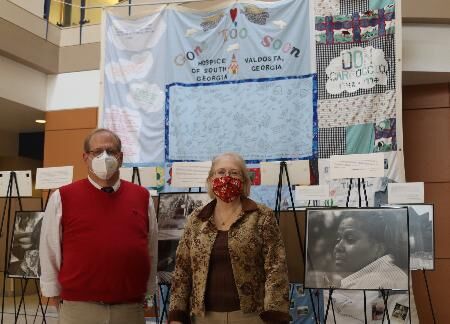VSU gets first-time AIDS awareness exhibit
Published 12:00 pm Thursday, December 9, 2021

- Amanda M. Usher | The Valdosta Daily TimesThe Hospice of South Georgia lists names of past patients who've died from HIV/AIDS on the National AIDS Memorial Quilt, shown in the Valdosta State University Odum Library as part of the AIDS at '40: A Retrospection' exhibit.
VALDOSTA – In the south end of Odum Library, tales of hardship and messages of hope are conveyed in observance of World AIDS Day, which was Dec. 1.
For the first time, Valdosta State University hosts “AIDS at 40: A Retrospection.” The name is symbolic of the 40th anniversary of the first reported case of HIV/AIDS, according to organizers.
The three-part display has panels from the National AIDS Memorial Quilt, works from photographer Billy Howard’s “Epitaphs for the Living” and the re-installation of “African-Americans Responding to AIDS: 1981-1991.”
The university Odum Library partnered with Georgia Equality and VSU Campus Pride for the exhibit. Georgia Equality is an advocacy organization for the state’s lesbian, gay, bisexual, transgender and allied communities.
The Purpose
In line with the purpose of World AIDS Day, which Georgia Equality stated is to draw global attention to the HIV epidemic, the exhibit follows a broader theme of “Ending the HIV Epidemic: Equitable Access, Everyone’s Voice.”
Deborah Davis, director of university archives and special collections, connected with the group on behalf of VSU.
“We’re hoping to raise awareness within the student body, within the community about AIDS because a lot of people think … AIDS is so yesterday,” she said. “It’s over but it’s not over; and so, we need to raise people’s awareness. It is something a lot of people are living with and there are a lot of people with infections, especially in this area.”
The Centers for Disease Control and Prevention states untreated HIV can cause AIDS.
Georgia Equality reported 2,492 people were diagnosed with HIV statewide in 2019. Of those reported, the agency stated 71% were Black.
With VSU having a significantly large African-American student population, Douglas Carlson, assistant archivist for VSU’s archives and special collections, said it was essential to bring “AIDS at 40: A Retrospection” to campus.
The exhibit shows the youth there’s still an “ongoing crisis” despite people believing AIDS is in the past, Carlson said.
Davis said the South Georgia region has the fourth highest new diagnosis rate across Georgia.
“It’s ongoing,” she said of the epidemic. “It’s important and people need to see the true past of the epidemic.”
The Features
Part of the display in Odum is Howard’s “Epitaphs for the Living.” Howard worked with people who were diagnosed with AIDS by photographing them, and then, having them share their stories through written messages.
Davis said most of the people captured in the images have died of AIDS. One of the photos is of an infant accompanied by the child’s handprint; no written message.
“It’s hurtful,” she said. “It’s sad and has a powerful message for us as we contemplate an ongoing AIDS epidemic.”
“African-Americans Responding to AIDS: 1981-1991” spotlights African-American activists from Atlanta who lent their efforts toward the HIV/AIDS epidemic in the 1980s.
According to a VSU statement, there are also depictions of caregivers, health professionals, community leaders and people who lived with HIV/AIDS through the initial years of the epidemic.
Few of those featured are community leader Craig Washington, Jerusalem House founding executive director Angela “Ann” Slaughter, ally Gwen Atwater-Roberts and Our Common Welfare founder and executive director Faye Brown-Sperling.
The collection is part of Emory University’s endeavors to document community oral histories, Carlson said. Quotes from each participant can be seen sitting above his or her photograph, sharing details of his or her involvement in fighting against the HIV/AIDS epidemic.
Hanging above the African-American display is part of the National AIDS Memorial Quilt from California. There are writings on it, words of remembrance from family members and friends of people who were diagnosed with HIV.
“It’s very poignant, very touching and brings a personal note to the suffering of people that live with HIV,” Carlson said.
The Hospice of South Georgia has the top center panel with names of former patients who’ve died from HIV/AIDS.
“The National AIDS Memorial Quilt is a powerful, visual reminder of hope, healing, activism, love and remembrance — and an opportunity to promote awareness about prevention and available treatments, especially in the South where HIV/AIDS impacts a significant number of young people and people of color,” the VSU statement read.
“The VSU exhibit features a selection of panels from this 54-ton, nearly 50,000-panel tapestry dedicated to more than 105,000 individuals. Each of the quilt’s 3-foot by 6-foot fabric panels memorializes someone lost to HIV/AIDS.”
The free exhibit will be open to the public through Dec. 15.
Visit https://bit.ly/3xZUkM4 for more information.




